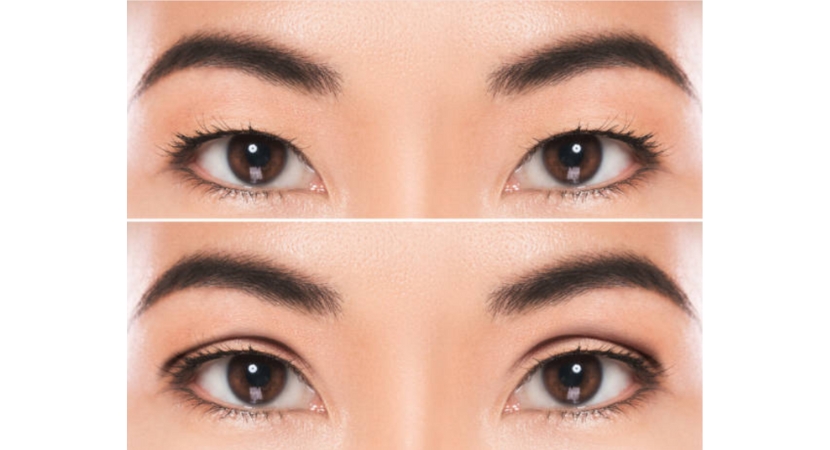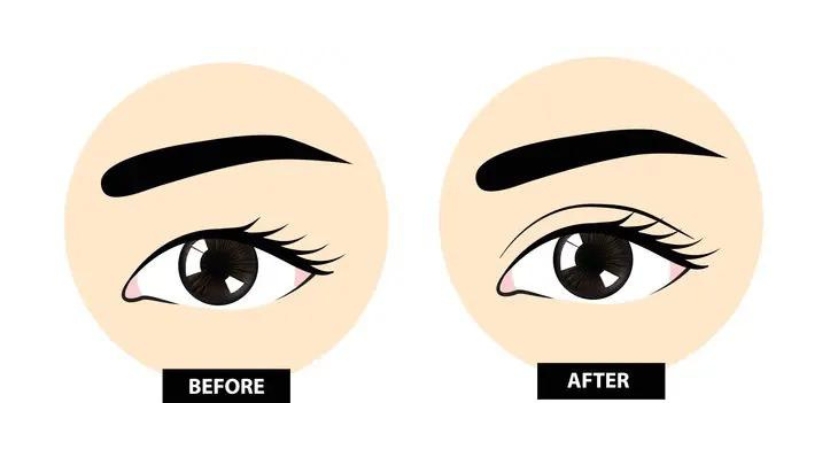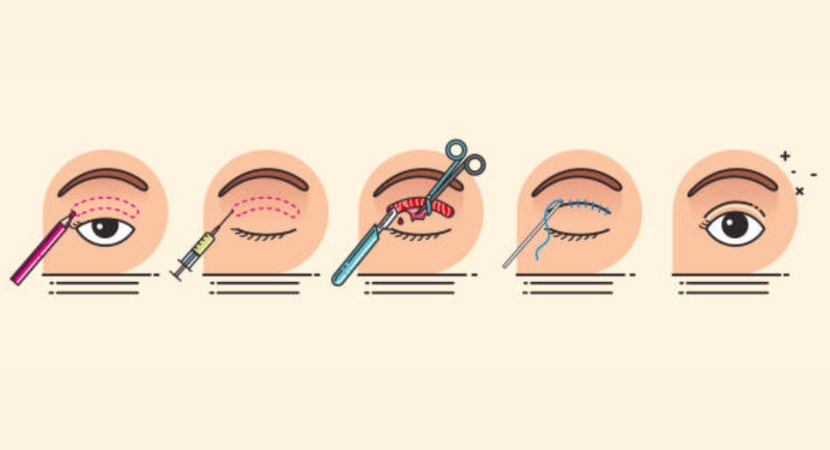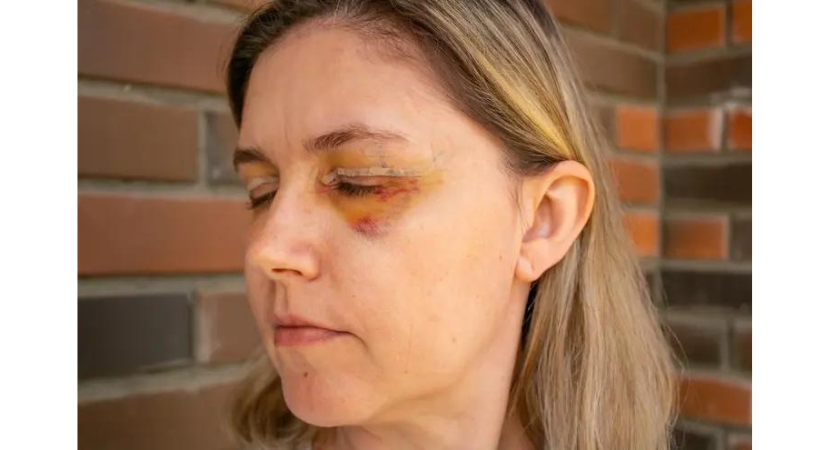
One distinguishing feature of the eye that varies from person to person is the number of folds on the eyelid. Double eyelids are those with a visible outer fold. This is in contrast to single eyelids or monolids, which have no folds. Genetics determines whether you have double eyelids or not. Surgery is available to reshape double eyelids. It can be done for cosmetic reasons or because the eyelid that does not have creases interferes with your vision.
Asian Eyelid Morphologies
Asians have a diverse range of eyelid morphologies. The arrangement of the internal structures of the eyelids, the presence of epicanthal folds, and the organization of the fat pads work together to create different Asian eye shapes. The presence or absence of a supraciliary fold is one noticeable difference between Asian eyes that has led to the desire for a double eyelid procedure. Asian eyelids are divided into three main categories, each with two subcategories.
Category 1 - Single Eyelid Crease
Subtype A - has a single eyelid without a visible eyelid crease.
Subtype B - has a low eyelid crease that is mostly hidden and tapers toward the nose.
Category 2 - Double Eyelid Fold
Subtype A - Fold type: the height of the supraorbital fold is lower than the epicanthal fold.
Subtype B - Crease Type. the height of the supraorbital crease is equal to or greater than the epicanthal crease.
Category 3 - Double Eyelid Crease (types with expansion)
Subtype A - Unfolding Type 1. The height of the eyelid crease is higher than the epicanthal crease.
Subtype B - Unfolding Type 2. There is a double eyelid fold but no epicanthal fold.

Different Types of Eyelids
Asians have a diverse range of eyelid morphologies. The arrangement of the internal structures of the eyelids, the presence of epicanthal folds, and the organization of the fat pads work together to create different Asian eye shapes. The presence or absence of a supraciliary fold is one noticeable difference between Asian eyes that has led to the desire for a double eyelid procedure. Asian eyelids are divided into three main categories, each with two subcategories.
There are several genetic disorders, such as Down syndrome, that cause people of all ethnicities to have more prominent epicanthal folds.
It is generally assumed that people of European descent have double eyelids, while people of East Asian descent have monolids - but this is an oversimplification. For example, in one study of eyelid shape, half of the Latino participants had monolids or epicanthal folds. Many people around the world, regardless of ethnicity, have heavier or "hooded" eyelids.
What is a Double Eyelid?
A double eyelid is an eyelid that has a crease or wrinkle on the upper eyelid. Because it is a dominant gene, it is more likely to be expressed or obvious, as opposed to a recessive monolid gene. Double eyelids are commonly associated with appearance and beauty, especially in Asian cultures.
Most people with a single eyelid often look for the best options to create double eyelids. Fortunately, there are several treatment options to consider depending on the desired goals. These include both surgical and non-surgical interventions.
Advantages of Getting Double Eyelids
The main reasons why people choose double eyelids include:
Improved Vision
Although this may come as a shock to you, it is the truth. Furthermore, not everything about double eyelids is meant to be attractive. Adding another eyelid on top of the existing one can also help you see better.
Helps Reduce the Appearance of Forehead Wrinkles
Another shocking discovery is that having a single eyelid may be the cause of forehead wrinkles. Whenever the eyes feel heavier, people try to raise their eyebrows to see better. Excessive skin at the top of the eyes creases as a result. With time, you will start to see deep wrinkles at the top of the forehead. Fortunately, you can prevent this by undergoing a procedure to remove excess fat in the eyes.
This Makes You Look More Alert and Less Tired
It is common to see people looking sleepy or exhausted despite the fact that they are fully awake or active. We come across such people every day. This is because such individuals have extra skin around the eyes that increases puffiness in the upper part of the eyes and forms bags under them. Thus, getting double eyelid creases can help correct this problem, giving you a more awake look.
Makes You Look and Feel Younger
Bags, wrinkles, and other unwanted creases around the eyes are major contributors to aging. However, this can be remedied with double eyelid surgery. As we age, some of the fat around the eyes tends to sag and droop down, making a person look older. With the procedure, you can acquire a younger appearance.

Surgery of Double Eyelids
A type of eyelid surgery that plastic surgeons may recommend to address a variety of issues is known as blepharoplasty. These problems may include the following:
• Skin that is loose or sagging, causing wrinkles or distorting the natural curve of the upper eyelid and sometimes interfering with vision.
• Puffiness around the eyelids due to fatty deposits
• Bags under the eyes
• Lower eyelids that droop and show white under the iris
• Extra skin on the lower eyelid and fine creases
• Reconstruction of aesthetic appearance
Asian Blepharoplasty is a term used to describe plastic surgery that is used to create double eyelids. This surgery is usually performed as an outpatient procedure to create a crease or fold in the upper eyelid in patients who do not have one.
Epicanthoplasty is a procedure that is sometimes combined with blepharoplasty. An epicanthoplasty involves removing some of the excess skin in the inner corner of the eye, known as the epicanthal fold. The natural formation of an outer crease is prevented by a severe epicanthal fold. As a result of removing a portion of the epicanthal fold, a crease can form naturally without tension or scarring.
Mikamo performed the first reported "double eyelid surgery" in 1896. Although this cosmetic procedure is often referred to as an attempt to achieve a more Western appearance, the first description of double eyelid blepharoplasty predates Western influence on Asian culture. As a result, Mikamo's development of double eyelid surgery is believed to have been motivated by a desire to achieve a more aesthetic, round-eyed, and expressive appearance.
Candidates for Double Eyelid Surgery
Double eyelid surgery can be performed for both cosmetic and functional reasons. On the cosmetic side, someone may choose eyelid surgery because they prefer the look of double eyelids to monolid eyelids.
Alternatively, they may choose surgery because the skin on their eyelids is sagging as a result of the natural loss of collagen and elastin in the skin that occurs with age. In some cases, the eyelids droop so low that they obstruct vision. Therefore, eyelid surgery can be used to correct droopy eyelids and prevent vision problems.
In general, double eyelid surgery is not suitable for every person. Moreover, there are several factors that you should consider before you decide to undergo the procedure. These factors include:
• Being in good health and having no major medical problems
• Not having any diseases or disorders that could delay or prevent healing.
• You are not a smoker
• Have reasonable goals for the outcome
• You must not have major eye problems.
People considering blepharoplasty should be aware that exaggerating the height of the wrinkle added to the eyelid can look artificial. Therefore, discuss your eye shape, facial structure, and goals for surgery with your plastic surgeon beforehand.
Surgical Preparation
The general preparation in the operating room is the same whether incisional or non-incisional blepharoplasty is performed. Preoperative preparation begins with marking the eyelid in the upright position to allow visualization of the final gravitational position of the eyelid. This is then assessed in the supine position. The proposed supra-tarsal crease is pulled from the medial to the lateral canthus at the patient's desired height. Once the symmetry of the scar in both the upright and supine position has been properly assessed, sterile preparation can be performed.
A corneal shield and local anesthetic is then applied to the upper eyelids. The procedure can be performed with or without intravenous sedation. Because few clinical or animal studies have been conducted to evaluate the efficacy of different types of sutures in facial surgery, the choice of suture material for the procedure is largely based on the surgeon's preference.

Disadvantages of Blepharoplasty
Blepharoplasties are generally considered to be safe outpatient procedures because most of the physical side effects are transient. Consider the following disadvantages of this procedure:
• Itching, swelling, bruising, and double vision may occur immediately after surgery, and these side effects may persist.
• If the surgery was purely cosmetic, you may feel self-conscious about your new appearance.
• Blepharoplasty is the most requested surgery in Asia, according to the American Academy of Ophthalmology. If your family, friends or culture pressure you to undergo cosmetic surgery, you may regret your decision.
• Blepharoplasty cannot be reversed, and double eyelid surgery is often quite expensive. This means that if you decide to have your eyelids surgically altered for cosmetic reasons, you need to be absolutely sure that this is what you want. You should wait until you are old enough to make your own decisions.
Blepharoplasty can be very helpful in alleviating the eyelid problem that causes vision problems - but it is important to remember that both double and monolid eyelids are normal, healthy eyelids. If you want to have cosmetic surgery on your own, check with your doctor and possibly a trusted friend or mental health counselor to make sure you're doing it for the right reasons.
Types of Double Eyelid Procedures
Your plastic surgeon will help you determine which surgical procedure is right for you. However, this will depend on your goals, face shape, other conditions, and length of treatment.
Asian double eyelids include a variety of procedures including:
Incision Approach
This involves creating an incision in the upper eyelid and removing the tissue. This approach is virtually painless and allows for greater customization of the final effect, as well as the removal of eye wrinkles. Because the skin of the upper eyelids is the thinnest in the body, the surgery may result in a barely noticeable scar, if present.
Although the scar is present, it may only be visible when the eyes are fully closed. Plastic surgeons who undertake this operation may use very small sutures that dissolve in six or seven days and do not need to be removed.
Closed Suture Technique
The plastic surgeon may create tiny holes and use three closed sutures to form a crease on the eyelids. This approach is ideal for people who desire a quick recovery without any scarring. However, double eyelids may fade over time and the eyelids may return to their normal state.
Stringing Technique
The threading procedure involves placing six sutures through the eyelid and stabilizing using a string so that it does not cut through the skin. Once the scars develop a double eyelid, the sutures are removed a few days later.
This is the least invasive option, although it causes a lot of inflammation, which is necessary for the double eyelid scar to form. Although this procedure does not require cutting or incision, it needs the most time to recover due to postoperative swelling.

Double Eyelid Restoration Procedure
Depending on the approach used, recovery after eyelid surgery will vary from one person to another. Incisional blepharoplasty leaves behind a scar. However, non-incisional blepharoplasty patients may endure more prolonged irritation and swelling after treatment.
In general, the length of time it takes to recover from double eyelid surgery is highly dependent on the type of surgery you had. Sutures will be placed using incision procedures and may need to be removed after a few days.
Initial recovery takes approximately two weeks, while full recovery can take months. You can expect to recover from surgery in about two weeks using partial incision and no incision procedures.
Care for Double Eyelids
Your plastic surgeon will provide you with detailed instructions on how to care for your eyelids after surgery. You will also learn how to manage the associated pain as well as discomfort. These aftercare measures include:
• Use a cold compress to relieve pain as well as swelling for the first two days. However, your eyes will remain swollen for weeks or even months after treatment.
• After surgery, do not lift anything heavy or exert yourself for at least three weeks. In most cases, you can start back to light activities after three days.
• Keep your head elevated throughout the day and do not sleep lying down. An extra pillow at bedtime will suffice.
• Stay out of the sun.
• Avoid using any kind of cosmetics. You can continue to use makeup after about 10 to 14 days after the procedure.
• Refrain from using any over-the-counter ointments and creams.
• Apply a thin layer of petroleum jelly twice a day on all external sutures.
• Do not wear your contact lenses for two to three weeks if you use them.
Complications of Double Eyelid Surgery
Asymmetric and excessively high creases
The most common complication is uneven eyelid height or shape, which can occur in up to 35% of cases. Asymmetric eyelid creases can be caused by differences in preoperative markings, inconsistencies in the amount of skin excised, uneven tension on the skin during supra-parietal fixation, and uneven amounts of fat excised.
After surgery, approximately 7% of patients have excessively high creases. If the folds extend above the upper border of the tarsal plate, they are considered too far superior. As stated above, the ideal position for the eyelid crease is 6 to 8 mm above the lid margin. Adhesions between the orbicularis oculi and the skin above the level of surgical fixation can cause this unnatural appearance. High folds can also be caused by excessive resection of preaponeurotic fat pads.
Blepharoptosis
Iatrogenic damage to the levator palpebrae superioris muscle and its aponeurosis can cause droopy eyelids after Asian blepharoplasty. Inadvertent detachment of the elevator from the tarsal plate, as well as scarring from excessive fixation of the aponeurosis to the muscle, impairs proper elevator function.
Bleeding
Bleeding is a potential risk with any procedure and can range from prolonged ecchymosis to massive hematoma. In all ethnicities, the incidence of bleeding is comparable to that of blepharoplasty.
Loosening of the threads
Some patients may experience a reappearance of loose skin and loss of the surgically created upper eyelid crease over time. However, this occurs in less than 3% of cases and is more common with the suture ligation technique and when resorbable suture is used. This is due to weakening of the suture attachment and failure of adhesion between the elevator muscle and the dermis. This complication can be avoided by removing the volume of orbital fat or by purposeful suturing to strengthen the levator-dermal junction and tarsal-dermal junction during supratarsal fold formation.
Inverted cilia
The presence of an epicanthal fold promotes downturned eyelashes, which explains why Asians have a higher incidence of trichiasis. The formation of a double eyelid can alleviate and assist the curvature of the cilia. However, if proper preoperative planning and postoperative care are not followed, the eyelashes of the upper eyelid can invert and expose the palpebral conjunctiva.
Disease of the ocular surface
As discussed in the preoperative evaluation section, double eyelid formation can cause or exacerbate mild dry eye symptoms. Ptosis, which can occur in people who do not have a crease in the eyelid, can prevent the development of dry eye. As a result, it is extremely important to evaluate the patient for the development of these complications during the preoperative period.
Ectropion
Injury to the zygomatic or recurrent buccal branches of the facial nerve during surgery can impair the function of the orbicularis oculi muscle. This can cause complications such as ectropion as well as a change in the position of the lower eyelid margin. Ectropion will also occur if the tension on the eyelid elevator is greater than what normal skin allows. This is due to improper placement of the lower elevator incision or lower skin flap.
Non-Surgical Approaches for Double Eyelids
Not everyone is willing to consider surgical procedures to achieve double eyelids. In such cases, there are a number of options that can temporarily change your single eyelids into double eyelids. These include:
Eyelid tape
This involves placing a small amount of tape over the upper eyelid. You will then use the wand-shaped tool that has the tape to press the eyelid upwards to make a crease. Continue pressing for nearly a minute to make sure that part of your eyelid is firmly adhered to the tape. These pieces of tape are in the shape of a crescent moon.
Makeup remover can be used to remove the tape. You can then apply your makeup as usual.
Eyelid glue
This involves using the brush with the bottle to apply eyelid glue to the top of the eyelid. Once the glue has dried for 30 seconds, you can use a stick-like object to press the lid and form a crease. It's also a good idea to continue pressing it for another 60 seconds. A makeup remover can be used to clean off the adhesive.
Consultation with a Doctor
There is a chance that complications may arise during your recovery, just as with any other surgical procedure. Monitor your health carefully and don't be afraid to contact your doctor if you have any concerns.
After the procedure, your doctor will most likely prescribe pain medication. If you are still experiencing pain after taking the medicine, please let your doctor know. Your eyes may feel slightly dry in the days following the procedure, but if the dryness is excessive, contact your doctor.
If any of the following occur during your recovery, seek medical attention immediately:
• Your stitches come loose or your incision opens
• You bleed from your incision
• You have changes in your vision
• Your scar is raised or looks too large
• Your scar is still red after four weeks
• It hurts or feels uncomfortable to blink or close your eyes
• You feel pain in your eye
You should also seek immediate medical attention if you have signs of infection, such as:
• Swelling, pain, warmth, or redness on or near your eyelid
• Red streaks leading from the incision
• Pus oozing from the incision
• Fever
Conclusion
Double eyelids are a genetically created trait. While double eyelids are a dominant trait, recessive single eyelids are quite common. In Asian societies where double eyelids are popular, surgery for double eyelids is widespread.
The surgical procedure is mostly aesthetic and can result in uneven eyelids or even loss of vision if your surgeon is not good.


